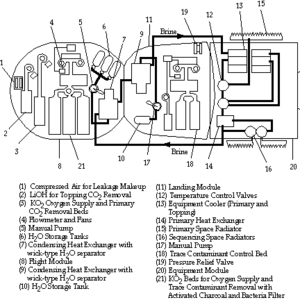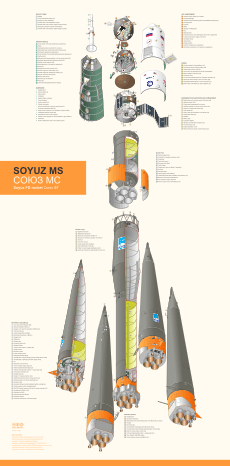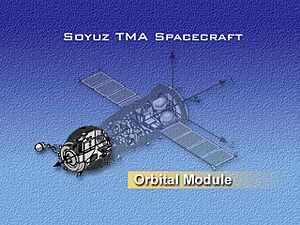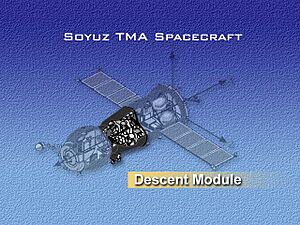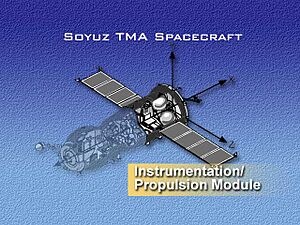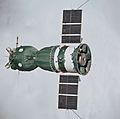Soyuz (spacecraft) facts for kids
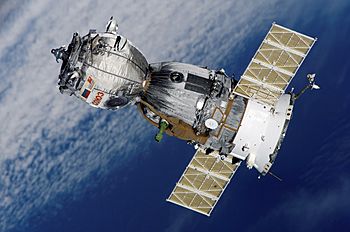
Soyuz spacecraft (TMA version)
|
|
| Manufacturer | RKK Energia |
|---|---|
| Country of origin | Soviet Union, Russian Federation |
| Operator | Soviet space program (1967–91) Roscosmos (1991 onwards) |
| Applications | Carry cosmonauts to orbit and back; originally intended for Soviet Moonshot and Salyut space station transportation. |
| Specifications | |
| Design life | Up to six months docked to station |
| Regime | Low Earth orbit (circumlunar spaceflight during early program) |
| Production | |
| Status | In service |
| Maiden launch | (Uncrewed) November 28, 1966 (Crewed) Soyuz 1 April 23, 1967 |
| Related spacecraft | |
| Derivatives | Shenzhou, Progress |
Soyuz (Russian: Союз, meaning "Union") is a type of spacecraft made for the Soviet space programme. It was first used in the 1960s. Soyuz spacecraft launch on Soyuz rockets, which are known for being very reliable. All Soyuz missions launch from the Baikonur Cosmodrome in Kazakhstan.
Contents
History of Soyuz
The first Soyuz flight had no people aboard. It launched on November 28, 1966. The first Soyuz mission with a crew, Soyuz 1, launched on April 23, 1967. Sadly, it crashed, and cosmonaut Vladimir Komarov died. Soyuz 3, launched on October 26, 1968, was the first successful mission with a crew.
Today, Soyuz is seen as one of the safest and most affordable ways to send people to space. Soyuz spacecraft have carried cosmonauts to space stations like Salyut and Mir. Now, they take astronauts to and from the International Space Station (ISS). A Soyuz spacecraft is always docked at the ISS. It acts as an escape craft in case of an emergency.
How the Soyuz Spacecraft Works
The Soyuz spacecraft has many important systems to keep the crew safe and help it fly. These include:
- Thermal control system: This system keeps the spacecraft at the right temperature.
- Life support system: This provides air, water, and food for the crew.
- Power supply system: This gives electricity to all the spacecraft's parts.
- Communication and tracking systems: These allow the crew to talk to Earth and help ground control track the spacecraft.
- Onboard control system: This system helps guide and manage the spacecraft.
- Propulsion system: This includes engines for moving the spacecraft in space.
- Motion control system: This helps the spacecraft stay in the correct position.
- Optical/visual devices: These are special cameras and sights for the crew to see outside.
- Kurs rendezvous system: This helps the Soyuz find and approach other spacecraft, like the ISS.
- Docking system: This allows the Soyuz to connect safely to a space station.
- Entry actuators system: This helps control the spacecraft as it comes back to Earth.
- Landing aids kit: This includes parachutes and small rockets to ensure a soft landing.
- Portable survival kit: This kit has emergency supplies for the crew after landing.
- Launch escape system: This is a safety system that can pull the crew capsule away from the rocket if there is a problem during launch.
|
|
|
Parts of the Soyuz Spacecraft
The Soyuz spacecraft has three main parts:
- A round orbital module, which gives space for the crew to live and work.
- A small reentry module, which brings the crew safely back to Earth.
- A service module with solar panels, which holds instruments and engines.
Orbital Module
The orbital module is also called the Habitation section. It holds all the equipment not needed for coming back to Earth. This includes experiments, cameras, and cargo. It also has a special collar for docking to space stations. This part of the Soyuz does not return to Earth.
Reentry Module
The reentry module is used for launch and the journey back to earth. Half of it is covered in special heat protection tiles. These tiles protect the module from the extreme heat when it enters Earth's atmosphere. This is the only part of the Soyuz that comes back to Earth with the crew.
Service Module
The service module has large solar panels that collect energy from the Sun. It contains important systems for temperature control and electric power. It also has systems for long-range radio communications and sending data back to Earth. This part of the Soyuz does not return to Earth.
Images for kids
-
Replica of the Soyuz spacecraft's entry module at the Euro Space Center in Belgium
-
Soyuz docked to Mir
-
Soyuz docked to ISS
See also
 In Spanish: Soyuz para niños
In Spanish: Soyuz para niños


